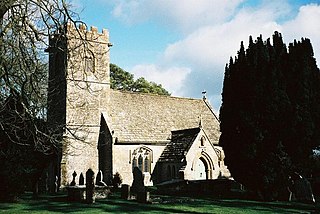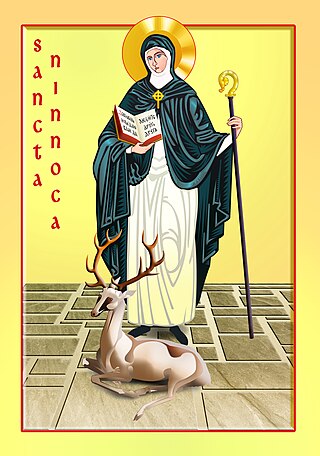Related Research Articles

Sabine Baring-Gould of Lew Trenchard in Devon, England, was an Anglican priest, hagiographer, antiquarian, novelist, folk song collector and eclectic scholar. His bibliography consists of more than 1,240 publications, though this list continues to grow.

Gwen Teirbron was a Breton holy woman and wife of Fragan who supposedly lived in the 5th or 6th century. Her epithet is Welsh for '(of the) three breasts'.
Salomon was a late 5th century Cornish 'warrior prince', possibly a King of Cornwall. His feast day takes place on the 18 October. He was the father of the Cornish bishop Saint Cybi.

Halstock is a village and civil parish in the county of Dorset in southern England, situated approximately five miles (8.0 km) south of Yeovil in Somerset. It lies on the route of the ancient Harrow Way. In the 2011 census the parish had a population of 546.
Breage or Breaca is a saint venerated in Cornwall and South West England. According to her late hagiography, she was an Irish nun of the 5th or 6th century who founded a church in Cornwall. The village and civil parish of Breage in Cornwall are named after her, and the local Breage Parish Church is dedicated to her. She is a saint in the Eastern Orthodox Church and Catholic Church.

June 3 - Eastern Orthodox Church calendar - June 5

July 12 – Eastern Orthodox Church calendar - July 14
Kea was a late 5th-century British saint from the Hen Ogledd —the Brythonic-speaking parts of what is now southern Scotland and northern England. According to tradition he was chiefly active in Cornwall, Devon and Brittany, and his cult was popular in those regions as well as throughout Wales and the West Country. Fili or Filius, to whom the parish church of Philleigh is dedicated, probably came from Wales and is said to have been a companion of Kea.

Winwaloe was the founder and first abbot of Landévennec Abbey, also known as the Monastery of Winwaloe. It was just south of Brest in Brittany, now part of France.

Sidwell was a virgin saint from the English county of Devon, She is the patron saint of Exeter and sister to Juthwara.
Branwalator or Breward, also referred to as Branwalader, was a British saint whose relics lay at Milton Abbas in Dorset and Branscombe in Devon. Believed to come from Brittany, he also gives his name to the parish of Saint Brélade, Jersey. "Brelade" is a corruption of "Branwalader". He is also known as Breward or Branuvelladurus or Brélade and Broladre in French.

Saint Budoc of Dol was a Bishop of Dol, venerated after his death as a saint in both Brittany and Devon. Saint Budoc is the patron of Plourin Ploudalmezeau in Finistère where his relics are preserved. His feast day was celebrated on 8 December, the date still used in Devon, but in Brittany this was moved to 9 December.

Lewtrenchard is a village and civil parish in the West Devon district, in the county of Devon, England. Most of the larger village of Lewdown is in the parish. In the Domesday Book of 1086, a manor of Lew is recorded in this area and two rivers have the same name: see River Lew. Trenchard comes from the lords of the manor in the 13th century.

Saint Teilo, also known by his Cornish name Eliud, was a British Christian monk, bishop, and founder of monasteries and churches. He was from Penalun (Penally) near Tenby in Pembrokeshire, south Wales.
Saint Senara, also known as Asenora, Sinara, or Sennara, is a legendary Cornish saint with links to the village of Zennor on the north coast of Cornwall, UK. The Church of Saint Senara, Zennor is dedicated to her, and according to legend her name inspired the name of the village of Zennor along with local features like Zennor Head and Zennor Quoit.

Wilgyth of Cholsey was a 6th-century Catholic female saint from Anglo-Saxon England who was venerated locally in Berkshire.

Tetha, also known as Teath, Tecla, and by a variety of other names, was a 5th-century virgin and saint in Wales and Cornwall. She is associated with the parish church of St Teath in Cornwall. Baring-Gould gives her feast day as 27 October, but this has been called a mistaken conflation with Saint Ia. In 1878, it was held on the movable feast of Whit Tuesday. Other sources place it on 1 May, 6 September, and (mistakenly) 15 January. It is no longer observed by either the Anglican or Catholic church in Wales.

Saint Avoye of Sicily, also known as Saint Auré or Saint Ewe, was a Christian martyr from the 3rd century, who was originally from Sicily, Italy. She died in Boulogne-sur-Mer, France around 234, according to tradition. She is recognized as a saint in the Catholic Church.

Saint Ninnoc or Ninnog of Breton, also known as Nenooc, Nennoca, Nennocha, Ninnoc, Ninnocha, and Gwengustle, was an early medieval abbess who was reputedly born in Wales and died in Brittany. The text of Vita Sanctae Ninnocae is preserved in the Cartulary of Quimperlé, and it provides knowledge of her life and works.
References
- ↑ Farmer, David Hugh. (1978). The Oxford Dictionary of Saints. Oxford: Oxford University Press.
- ↑ St. Aude Wyry alias St. Juthwara.
- ↑ Sheard, K. M. (2011). Llewellyn's Complete Book of Names: For Pagans, Wiccans, Witches, Druids, Heathens, Mages, Shamans & Independent Thinkers of All Sorts who are Curious about Names from Every Place and Every Time. Woodbury, MN: Llewellyn Publications. p. 319. ISBN 978-0-7387-2368-6.
- ↑ Baring-Gould, Sabine & Fisher, John. (1907). The Lives of the British Saints. The Honourable Society of Cymmrodorion.
- ↑ Orme, Nicholas. (1992). Nicholas Roscarrock's Lives of the Saints: Cornwall and Devon. Devon and Cornwall Record Society.
- ↑ Sabine Baring-Gould (1900). A Devon And Cornwall Calendar. p. 374.
{{cite book}}:|work=ignored (help)